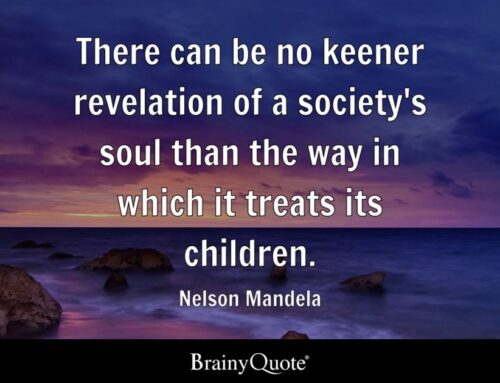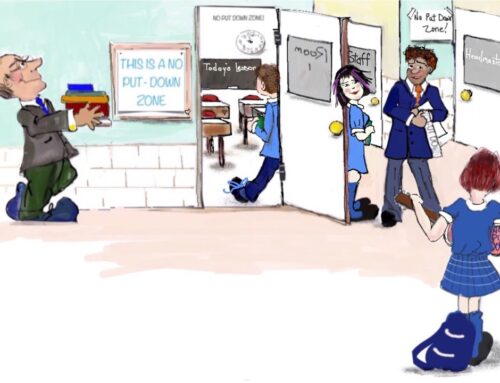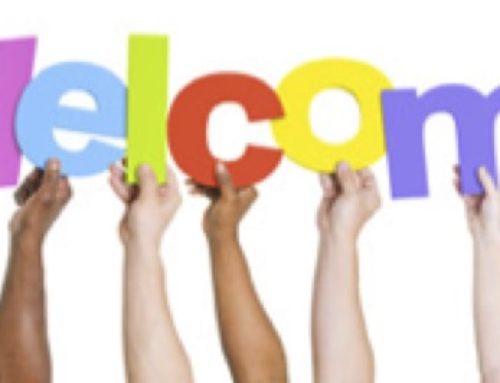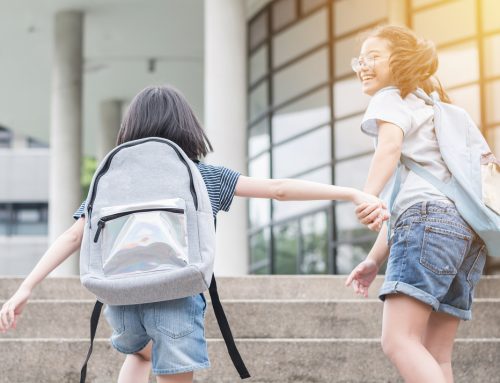Why do relationships break down?
On the surface it may look like teacher student relationships break down because of the specific interactions between individuals in the classroom. Sometimes this culminates in explosive incidents where both parties blame the other. There is, however, little linear cause and effect either in the establishment of relationships or in their breakdown. Instead an interaction of complex perceptions and feelings determine how people relate to each other at any given time.
Making sense of the world:
Students arrive in a classroom with a set of both personal and social constructs about the way the world works. These will have developed from their experiences from early childhood but confirmed by their expectations and beliefs. This means they interpret the world and what happens to them in the light of what they currently understand. If, for instance, conforming to behavioural expectations in a classroom has resulted in approval from significant adults leading to a feeling of pride and self–worth then the student will anticipate more of the same. ‘Getting into trouble’ may be a source of shame and these young people will be motivated to re-establish their reputation as ‘good students’. On the other hand, a pupil who has had less positive experience and anticipates rejection or failure is more likely to respond negatively to innocuous comments and feel hurt and angry before any alternative possibility is considered. Once these emotions have kicked in the possibility of a rational explanation is diminished. Some students will have had experiences which have led them to believe that they have little control over what happens to them.. Such individuals find it harder to accept responsibility for their own actions – for both positive and negative outcomes.
It might be that more recent events have turned a student’s world upside down. They may be trying to make sense of what has happened with confused information and mixed feelings. These individuals are easier to work with if responses to their behaviour acknowledge their interpretation of the situation, however erroneous it may seem to an observer. This does not mean condoning behaviour but finding out what it means for the student. This is, however, unlikely to be answered by the question “Why did you do that?” Family breakdown, for instance, is not immediately obvious as a cause of angry outbursts. But without mediation many children interpret someone leaving as their fault. This is often accompanied by the anger of unresolved grief and rejection which is safer to express in school than at home.
Unhelpful constructs for students may include one or more of the following:
- The world is not a safe place – I need to protect myself at all costs
- People in positions of authority are out to put you down
- You have to make a nuisance of yourself before anyone takes notice
- Get the better of others before they get the better of you
- School has never done anything for me so why should I do anything for teachers
- School and teachers are irrelevant – what is important is the rest of my life
- Learning is a mug’s game – I can’t succeed so it’s not for me
- Everything is unfair, why should I bother?
- You can be in control by being aggressive
- It’s better to shout and scream and lash out if you are upset – it’s not OK to cry
- I can’t change anything – everything happens to me
- I’m just a bad person so I’ll act that way.
The emotional content:
Emotions are an integral component of individual constructs. Anxiety and depression are often masked as defiance, which, as an ‘externalising behaviour’, takes up the available attention. The sadness underlying fury is rarely considered important as it does not present as something that needs to be ‘managed’. Other emotions are linked to protection and defence. Presenting parents with a list of their child’s misdemeanours is unlikely to be helpful in establishing a collaborative relationship. Parents will either be overcome with shame and embarrassment or will become defensive. Teachers’ frustration with ‘not getting the message across’ rarely acknowledges that parents have a different but equally important role to fulfil. Once this is understood it opens up different and more effective ways of discussing issues.
The extent to which an emotion is present depends on what has been triggered recently. If the student has had a terrible weekend or if the teacher in the previous class has had a confronting incident where the student feels aggrieved, then the next teacher is likely to have a bruised ego to contend with. Feelings are also linked to expectations. If a student’s past experience with history has been fraught with failure and conflict, then a history teacher might be in for a more testing time than a sports teacher where experiences have been happier. If, however, a positive relationship with a student has been established, then the impact of an event earlier in the day will be moderated by the student’s expectations of safety and support.
Teachers too are working within the framework of constructs that they bring into the classroom. Their personal constructs will include their own sense of competence and what they believe is required to be considered a ‘successful’ teacher within their school. Teachers also bring their own emotional factors which include a range of feelings such as frustration, compassion, interest, competence and anger. The school system impacts on these. A teacher may feel supported as a member of an emotionally literate culture or fearful of criticism within an authoritarian one.
Behaviour in context
Behaviour is only ‘bad’ or ‘good’ within the context which gives it meaning: shouting and screaming is not tolerated in a law court but is part of the fun at a football match. It is usually clear what is expected behaviour in a classroom, and to a greater or lesser extent everyone conforms to this. Difficulties only arise when students behave in ways which do not conform to expectations – and this is usually because other things override their commitment to do so. We all live in systems which impact on our experiences, thinking, conversations, actions and relationships. Certain values held by society are espoused by politicians and determine educational policy and practice. Teaching, learning and behavioural expectations are all implicated in this. What goes on in a classroom is also influenced by the culture and values of a specific school. Not only do these systems impact on us but we also influence systems. What we say and do matters beyond the immediate.
A range of teacher responses to student challenge:
The following constructs are related to how the teacher responds. These are just a few of the possibilities:
- I will not be seen as a good teacher if this student gets away with not doing as I say
- This young person seems to be having a hard time
- I am going to pretend this isn’t happening – it is safer to ignore this student
- I’m in charge here – how dare this person defy me
- This student is making my life a misery
- This student has a conduct disorder
- I need to reduce the tension in my classroom
- I don’t think its right that I should have to deal with such behaviour in my class
- I’m scared I might get hurt
- People who don’t want to learn shouldn’t be here
- Conflict can be resolved once things have calmed down
- I just feel incompetent and stupid when this happens – it must be my fault.
It doesn’t take much to realise that relationships in the classroom break down for a whole range of complex and interactive reasons:
- What has happened for the student and for the teacher in the distant and recent past
- Varying values and expectations in different systems
- How all of this impacts on constructs about self, school, behaviour and learning
- What emotions are being brought into play
Although difficulties in interactions are usually the trigger rather than the cause of challenging behaviours, what we do know is that some teachers manage to relate reasonably well to even the most difficult of students, whilst others seem to exacerbate difficulties. What are skilled teachers doing that not only keep explosions at bay but gives an opportunity for more helpful constructs to develop? In which ways can teachers and students co-construct relationships which are as meaningful and rewarding as possible within the constraints of the systems in which both are living and working?
Reasons for re-building
On the surface, an entrenched relationship breakdown occurs because each individual feels that the other does not like or respect them or wants to ‘win’ control over the situation. Neither will take responsibility for their contribution for the breakdown in communication and neither will back down. Such a negative situation rarely stays stable. If things do not improve they will deteriorate. It is, of course, possible that one of the people within this relationship will leave altogether. At best this is but a temporary resolution.
Reversing the downward spiral:
When students do not behave well in school a downward spiral often follows. Students who fail in the school system often become either the socially excluded in society or the thorns in the side of communities – potentially reinforcing the cycle of disadvantage in the next generation. What happens in school can impact on that spiral – and relationships are at the crux of what is effective. Behaviour management strategies depend on relationships with significant adults to be optimally effective. The emphasis is on significant – the adult has to matter to the student.
Fostering a sense of belonging:
A feeling of ‘belonging’ is key to resilience. Having at least one person who shows they care and are supportive, who show they value a young person for who they are – even if they disapprove of what they do – is a strong protective factor. Making the effort to repair a relationship may have far reaching outcomes. It can be the one thing that keeps the young person from giving up on themselves.
Learning:
If the teacher models skilled communication and both intra and interpersonal skills in the re-building of a relationship this in itself is a significant learning experience. Students who are the most difficult have had little in the way of good models for social interaction and personal effectiveness – if they don’t get this at school there is little chance they will ever learn more effective and emotionally literate ways of being
Having a more satisfying professional experience:
The other reason for re-building is basically self-interest. Efforts in fostering positive interactions bring rewards beyond the immediate situation. Not only will life in the classroom be somewhat more peaceful with this particular student but skilled relationship building brings credibility with others in the class. Once a teacher has learnt some of the specifics of relationship management with one student then these skills generalise to other difficult situations.
Overcoming barriers to repair
The biggest barrier to repair in students is the extent to which they have lost trust in others or a sense of belief in themselves. Older students who have had few if any positive experiences and little reason to affiliate to school the barriers may be hard to shift. For younger students and those who are having more recent or temporary difficulties there is a good chance that there will be foundation stones for building better relationships.
The barrier to repair in teachers is usually based in blame which focuses, sometimes exclusively, on the young person. Teachers may say that students know what behaviour is acceptable and should therefore conform to what is ‘right’. If the breakdown is squarely placed on the student it follows that they will be required to make the first step toward any repair. This may be a demand to ‘apologise’, ‘ make amends’ or promise ‘better behaviour in the future’. Students who feel they have been treated unfairly are unlikely to respond positively to this ‘opportunity’; to acknowledge that they are at fault, especially at the height of the conflict. They may later grudgingly do what is required to prevent suspension or other punishment, but it does not do a great deal for future interactions. It simply serves to confirm the construct that those in authority are out to get you.
Teachers are those with power and authority in the school system. They can use this to insist on student conformity to the rules or they can re-interpret their role as a responsibility to take the first step towards mediation. This does not mean condoning behaviour but getting a fuller picture of the student’s interpretations, acknowledging that misunderstanding or overhastiness may have contributed to the breakdown in a relationship and that there are times when emotions on both sides can get out of hand.
What works in establishing good student teacher relationships?
There is now a body of research which makes it clear that good relationships are a significant factor in developing positive behaviour. This inhibits difficult situations arising in the first place, and provides a cushion when challenges do arise. Relationships are actioned by what is said and not said and messages that are given about value and expectations. The following summarises statements from students about their teachers.
- Teachers should treat all the kids the same – not having favourites like the ‘good’ students
- Everyone knows that some students need more help – that is accepted
- Being consistent matters – getting into trouble for something one day because a teacher is in a bad mood but not another day means you don’t know where you are
- Knowing the students’ names and talking with them about things in their lives makes them feel that they matter
- Teachers who don’t shout get more respect – though doing it occasionally is OK
- Talking as an equal – not talking down to students – is good
- It’s good to have teachers you can approach, who don’t make you feel stupid when you don’t know something
- Teachers should be friendly but not try and be your friend
- Teachers should walk the talk – they shouldn’t expect things from students they aren’t prepared to do themselves
- Teachers need to be confident in themselves, then students will have confidence in them
- Teachers should know what they are teaching but not try and be above you all the time
- Teachers need to listen –some jump to conclusions about things:
“I had a hard time at home and at school and this one teacher made a real difference for me. He showed that he cared whether I was there or not, whether I learnt anything. He didn’t give up on me. It’s because of him that I stayed in school. I don’t think teachers should say ‘its up to you whether or not you learn’ – it makes it seem they don’t care about you.” (This young person is now training to be a teacher herself)
Specific actions in developing good relationships can be summarised as follows:
Show the student he or she matters, by:
- Greeting by name, smiling; showing an interest by comments and questions
- Finding something to like or admire and commenting positively on qualities and strengths. This may position the student and their behaviour differently – attributing to them resourcefulness, humour, protectiveness, spirit in the face of adversity etc. This may also give the student an alternative self concept to work towards
- Giving regular positive feedback which is specific, genuine and brief
- Showing belief, trust and high expectations
- Showing that their success, safety and well-being matters.
Show acceptance of the person but not their behaviour by:
- Stating what students are expected to do rather than what they shouldn’t be doing – information is much easier to hear than accusation
- Using ‘I’ statements rather than ‘you’ statements which refer to behaviour not people
- Offer comfort in distress
- Giving choices which give the student some control and promote self efficacy
Develop a sense of inclusion and belonging by:
- Ensuring that there are experiences which guarantee success – however small
- Ensuring that there is fairness – giving each their turn
- Framing behaviour in terms of equity rights, e.g. “You are not allowed to hurt another student and other students are not allowed to hurt you”
- Encouraging students to take a responsibility and giving positive feedback for this
- Using the word ‘we’ and ‘our’ to include, not to exclude
- Avoiding unfavourable comparisons or put downs
- Avoiding self fulfilling prophecies
- Doing everything possible to avoid sanctions that are about exclusion
- Welcoming students back if they have been absent
- Speaking about the student positively to others.
What works in responding to challenges
Specific responses will of course depend on specific contexts. A teacher would react differently if there was an implicit danger than if the challenge was refusal to work.
These suggestions are ways in which difficult and unco-operative behaviour can be addressed while maximising the maintenance of a respectful relationship.
- Check intentions: some students overstep the mark without fully realising it. Check: e.g. “Did you intend to be rude – I don’t want to assume this but you are giving me that impression?”;“Are you trying to avoid doing any work this morning or are you just taking a lot of time getting down to it?”
- Check understanding: e.g. “Do you know what you are meant to be doing?”; “Do you have everything you need?”; “Do you need some help here?”
- Re-state expectations of the class and give ‘proximity praise’ to people who are doing as requested near to the student who is not conforming
- State expectations calmly. The tone and volume of voice is as important as the words that are said – especially for younger students.
- Where possible giving the student opportunities to make some choices both shows teacher control and respect for the student. The way these choices are given is crucial. “If you don’t do this now, then …” entrenches opposition.
- Make calm requests and moving away to give the student a chance to decide what to do can de-escalate a confrontation – don’t stand over them
- Being calm and in control models appropriate behaviour and assists a student in calming themselves. Anger exacerbates anger.
- Make statements that show care and concern for the student is more likely to maintain relationships. It is easy to construe student behaviour as personally and socially offensive and take a hard line. Understanding that this situation has arisen from a history of construct development will give an alternative response
- Acknowledging feelings being expressed: e.g. “I can see you might have a reason to be angry or upset here. Its OK. Try and settle down as quickly as you can manage”. If necessary, offer a ‘time-out’ to calm down
- Use non-labelling statements e.g. “I do not want to hear that language in this classroom”is better than “You are rude and insolent”
- Avoid unfavourable comparisons and put downs. These will badly damage any chance of re-establishing rewarding interactions.
Focusing on emotional literacy
The teacher who is able to stay calm, acknowledge feelings and show interest in the well being of individuals will win greater respect and have an easier time. Emotional literacy is aligned to self respect, self control and regard for the other – all of which are linked to good relationship development and classroom management. In schools with an emotionally literate culture adults model behaviours required of the students. A whole school approach can make a positive difference to the development of social and emotional competencies, behaviour, communication and relationships at all levels. Programs aimed only at students have a limited and short-lived impact. Policies only go so far – it is the consistency of practice that counts.
Emotional literacy and promoting positive relationships
The following are ways in which emotional literacy is most likely to maximise positive student teacher interaction
- Acknowledging and validating feelings in the first instance, before trying to ‘fix the problem’
- Giving students time and space to come down from a high level of emotion – not trying to ‘get to the bottom of things’ when feelings are running high
- Being aware of personal responses and how to regulate emotions such as anxiety and fear
- Being calm, speaking quietly but not being bland – others need to know that what they do matters
- Being prepared to listen – if not at the time then later
- Checking the meaning a behaviour has for a student in order to understand how they come to feel what they do
- Taking challenging behaviour personally is emotionally draining. It is useful for teachers to understand their personal triggers so that students have less chance to succeed in baiting.
- Being sensitive to the emotional content of a situation means that teachers say things that soothe rather than exacerbate difficult feelings. These emotions may be expressed as anger and defiance but also incorporate rejection, hopelessness and injustice.
- Use all opportunities to demonstrate concern, care and belief in the young person
- Maximising emotional resources such as having enough sleep, debriefing with a trusted colleague and anything else that ensures that incidents are kept in perspective
- Giving good emotional regulation and expression models – showing students that there are ways to feel better about yourself and express what you feel without damaging others.
- Focusing on and building on the positive in any situation rather than maximising the negative, the deficit and the difficulty. This includes conversations with and about the students and their parents. It also includes not being too hard on yourself.
Maintaining professional integrity
Sometimes nothing seems to work. So what do you do? The answer lies in maintaining a high level of personal and professional integrity. Teachers need to behave in a way which is consistent with how they want the student to behave, even if they are currently not doing so. Whatever a student does a teacher has choices in response. Focusing on the negativity within the situation wastes valuable emotional resources and damages the possibility of relationship re-building. It is better to state clearly and calmly what is expected, model appropriate behaviour, state consequences calmly and follow through consistently. This maintains both self respect and respect for the student. It is important to also clarify how the school system supports teachers –so long as this is not at the expense of the student. A teacher’s self-respect does not lie in pupil compliance.
Students whose lives have been enmeshed with unsupportive relationships, poor role models and/or values which are contrary to those of the school do not change overnight, especially if they are into adolescence. Some are too damaged, too angry and too distressed to trust anyone’s good intentions – especially in the short term, But individuals do change incrementally over time in a consistent and emotionally safe environment – and some respond to a different approach surprisingly quickly.
A strategy is only as good as the context in which it is embedded – and relationships are the most significant factor in determining their success.
Sue Roffey’s books on behaviour include:
- Changing Behaviour in Schools: Promoting Positive Relationships and Wellbeing (Sage)
- The New Teacher’s Survival Guide to Behaviour (Sage)
- The Primary Behaviour Cookbook: Strategies at your Fingertips (Routledge)
- The Secondary Behaviour Cookbook; Strategies at your Fingertips (Routledge)








Leave A Comment
You must be logged in to post a comment.